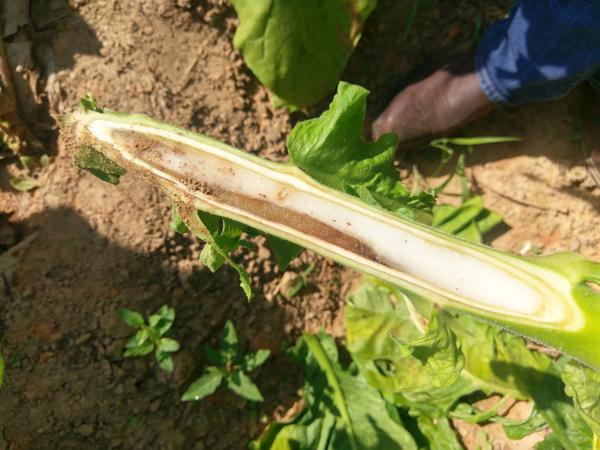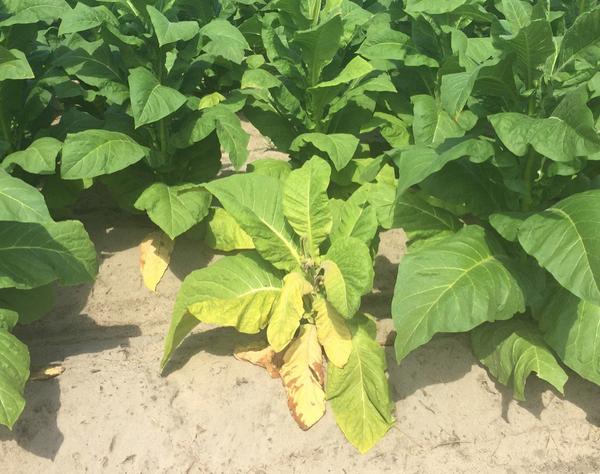Introduction
Granville wilt, more commonly known as bacterial wilt, is one of the most devastating diseases of flue-cured tobacco in North Carolina. First reported in Granville County, North Carolina in 1881, the disease has spread to all major tobacco-producing counties in the state. Under favorable environmental conditions for disease development, field losses can vary from 25 to 100%. Current management strategies rely on integrated pest management (IPM) practices, which incorporate soil fumigants, crop rotation and sanitation.
Pathogen
Granville wilt is caused by the soil-borne bacterium Ralstonia solanacearum, which is endemic to the Southeast United States.
Symptoms
Wilting and yellowing of younger leaves are the characteristic symptoms observed in hosts susceptible to R. solanacearum (Figure 1). The wilt is often restricted to one side of the plant or one side of the leaf mid-vein (unilateral). As the disease progresses, the leaves turn yellow and scorch-like symptoms may be expressed at the margins, and between the veins, followed by a total collapse of the plant. Stunting and leaf distortion may be observed in plants that do not die.
Primary and secondary roots may rot, which can be observed when symptomatic plants are dug from the soil. When performing a cross section along the central axis, a reddish to brown discoloration of the vascular system (Figure 2), a hollow stem due to the pith rotting, and lesions on the stem surface may be observed.
Symptom severity and development is directly affected by water availability and temperature. At times of heavy rains or warmer temperatures above 80ºF, symptoms will develop and affect the whole plant faster than in cooler, dry conditions.
The bacteria grow in high densities within infected tissues. A common sign of the bacterial pathogen is a milky, white bacterial streaming that can be seen when the bottom of the stem from an infected plant is cut and placed in a tepid cup of water.
Diseases With Similar Symptoms
Fusarium Wilt (Fusarium oxysporum, Figure 3)
This pathogen can produce yellowing and wilting of leaves, and browning of the pith. The causal organism of Fusarium wilt is a weak pathogen, and often requires other damages to the roots, such as poor environmental conditions or nematode infestations.
Black Shank (Phytophthora nicotianae, Figure 4)
Root and crown infections are characterized by rapid yellowing, wilting of leaves, and eventually plant death. At the ground level, a dark brown to black lesion often appears on the stalk. When cut open, the lower stem and crown often show blackened pith with distinct disks and white hyphae.
Disease Cycle
Ralstonia solanacearum survives on crop debris (saprophytically) in soil or on an alternate host until tobacco is planted. The bacterium is motile, allowing it to move short distances in a field. Long distance spread occurs through anything that moves infested soil or water, including splash dispersal, movement of infected plants, or movement of soil on equipment. Ralstonia solanacearum attaches to the roots and enters through wounds from nematodes or cultivation or natural openings, such as the beginning of lateral roots. The bacteria colonizes the root, and will move from the roots up the stem via the natural movement of water in the plant’s xylem. The bacteria will continue to grow in the xylem, eventually clogging the plant’s vascular system and causing the plant to collapse.
Disease Management
There are few effective management strategies for Granville wilt of tobacco. Single control methods are usually inefficient at reducing bacterial wilt. Current control methods for bacterial wilt rely on integrated pest management (IPM), which combines multiple disease control strategies, including host resistance, crop rotation, and pesticides.
Crop Debris Destruction
-
The bacterium can survive in soil on crop debris.
-
Destroy all stalks and other debris from fields, as soon after harvest as possible. Till debris as deep into the soil as possible, while managing soil erosion.
-
Burning is not an effective control method as it only removes the debris on the surface. If burning is used to remove excess debris, it should be combined with tillage to push debris to deeper levels of soil.
Crop Rotation
-
The longer the crop rotation, the more beneficial the rotation is at lowering the disease pressure.
-
A rotation of at least four years with three non-host crops is best for the control of Granville wilt.
-
-
Soybean, small grains, fescue and lespedeza are some non-host crops.
Weed Management
-
Weeds, such as ragweed can act as alternative hosts for the bacterium, and should be managed to reduce bacterial populations.
Resistant Varieties
-
Resistant varieties are the most economical management tool for reducing the impact of Granville wilt damages.
-
Available tobacco varieties and their level of resistance to the most economically important diseases are provided annually in the Tobacco Extension Portal or Flue-Cured Tobacco Guide.
Chemical Controls
-
Soil fumigants are the most common type of pesticide used for managing Granville wilt.
-
Fumigants containing chloropicrin are the most effective at reducing R. solanacerum inoculum.
-
These may be efficient controlling Granville wilt when used in combination with other cultural control practices, but losses have been documented with their use.
-
Biological Controls
-
Biocontrol agents are living organisms, so their efficacy may be impacted by variety used and annual environmental condition changes.
-
NC471’-McGill Compost and ‘NC196’-Serifel combinations have led to significantly less disease incidence.
Useful Resources
- The NCSU Plant Disease and Insect Clinic provides diagnostics and control recommendations.
- The NC State Extension Plant Pathology Portal provides information on crop disease management.
- The North Carolina Agricultural Chemicals Manual provides pesticide information for common diseases of North Carolina. The manual recommendations do not replace those described on the pesticide label, and the label must be followed.
- For assistance with a specific problem, contact your local N.C. Cooperative Extension agent.
Publication date: Feb. 5, 2019
Reviewed/Revised: Nov. 6, 2024
N.C. Cooperative Extension prohibits discrimination and harassment regardless of age, color, disability, family and marital status, gender identity, national origin, political beliefs, race, religion, sex (including pregnancy), sexual orientation and veteran status.
NC Cooperative Extension prohíbe la discriminación por raza, color, nacionalidad, edad, sexo (incluyendo el embarazo), discapacidad, religión, orientación sexual, identidad de género, información genética, afiliación política, y estatus de veteran.
Recommendations for the use of agricultural chemicals are included in this publication as a convenience to the reader. The use of brand names and any mention or listing of commercial products or services in this publication does not imply endorsement by NC State University or N.C. A&T State University nor discrimination against similar products or services not mentioned. Individuals who use agricultural chemicals are responsible for ensuring that the intended use complies with current regulations and conforms to the product label. Be sure to obtain current information about usage regulations and examine a current product label before applying any chemical. For assistance, contact your local N.C. Cooperative Extension county center.
N.C. Cooperative Extension prohibits discrimination and harassment regardless of age, color, disability, family and marital status, gender identity, national origin, political beliefs, race, religion, sex (including pregnancy), sexual orientation and veteran status.




